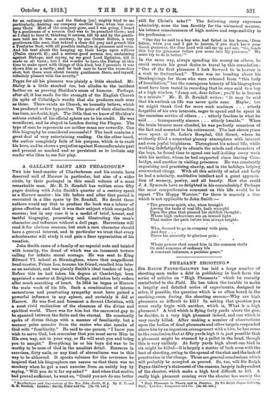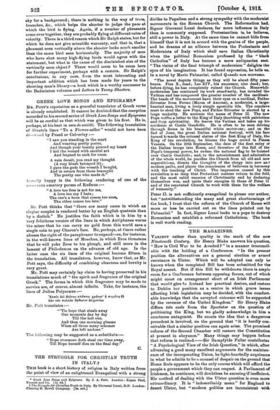PHEASANT SHOOTING.*
SIR RALPH PAYNE-GALLWEY has laid a large number of shooting men under a debt in publishing in book form the series of articles on "High Pheasants" which lie recently contributed to the Field. He has taken the trouble to make a lengthy and detailed series of experiments, designed to solve, if possible, the question which is so often heard in the smoking-room during the shooting season—Why are high pheasants so difficult to kill? In asking that question you must really begin with another, which is, What is a high pheasant ? A bird which is flying forty yards above the gun, he decides, is a very high pheasant indeed, and one which is very rarely killed. After making a number of observations upon the bodies of dead pheasants and other targets suspended above 'limb), an ingenious arrangement with a kite, he has come to the conclusion that at fifty yards high it is just possible that a pheasant might be stunned by a pellet in the head, though this is very unlikely. At forty yards high about one bird in six might be killed—it is largely a matter of luck even with the best of shooting, owing to the spread of the shot and the lack of penetration in the charge. These are general conclusions which will probably be accepted as proved. So, too, will Sir Ralph. Payne-Galiwey's statement of the reasons, largely independent of the shooter, which make a high bird difficult to kill. A really high pheasant coming over the shooter has merely the • High Pheasants in Theory and in Practice. By Sir Ralph Payne-Galiwey, Bart. London: Longmans and Co. [4s. 6cl. not.]
sky for a background ; there is nothing in the way of trees, branches, &c., which helps the shooter to judge the paoe at which the bird is flying. Again, if a number of pheasants come over together, they are probably flying at different rates of velocity. There is a third reason which Sir Ralph states, but for which he does not give scientific warranty, and that is, that a pheasant seen vertically above the shooter looks much smaller than the same bird seen horizontally. The majority of men who have shot many high-flying birds would agree with the statement, but what is the cause of the diminished size of the vertically seen object P There would seem to be room here for further experiment, perhaps with a camera. Sir Ralph's conclusions, in any case, form the most interesting and important addition which has been made for years to the shooting man's library—a book which is a worthy successor to the Badminton volumes and Letters to Young Shooters.



































































 Previous page
Previous page